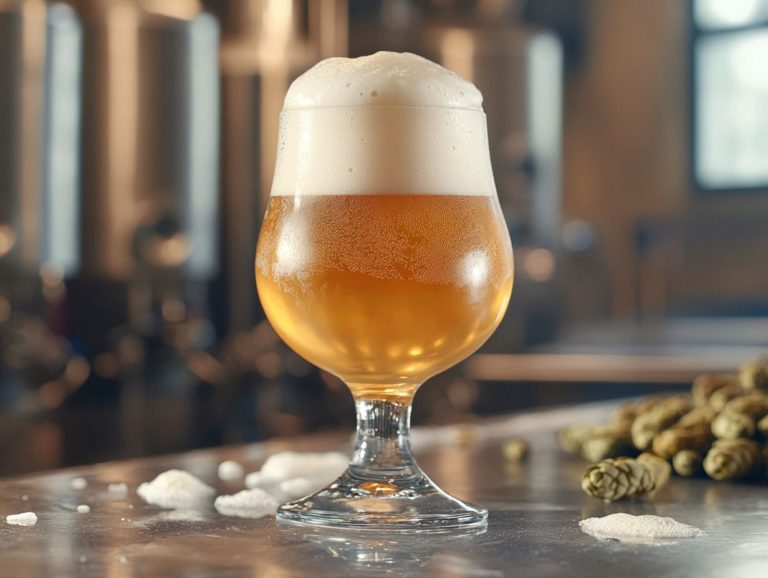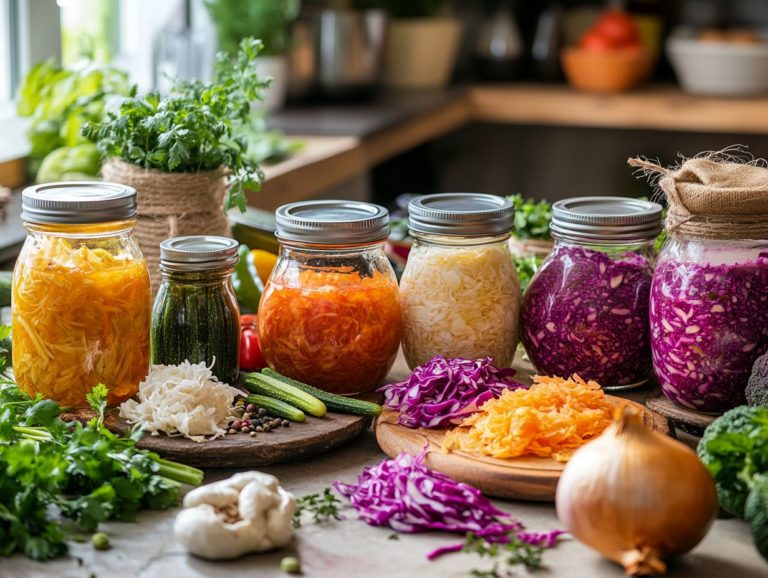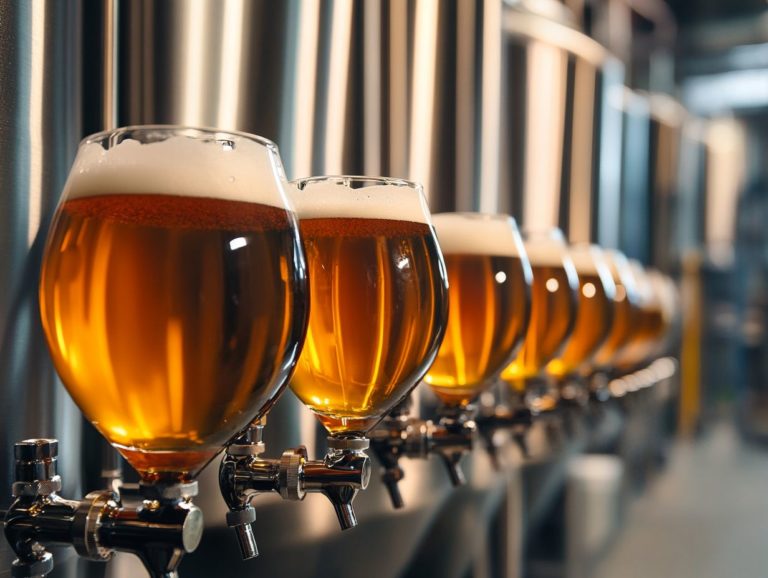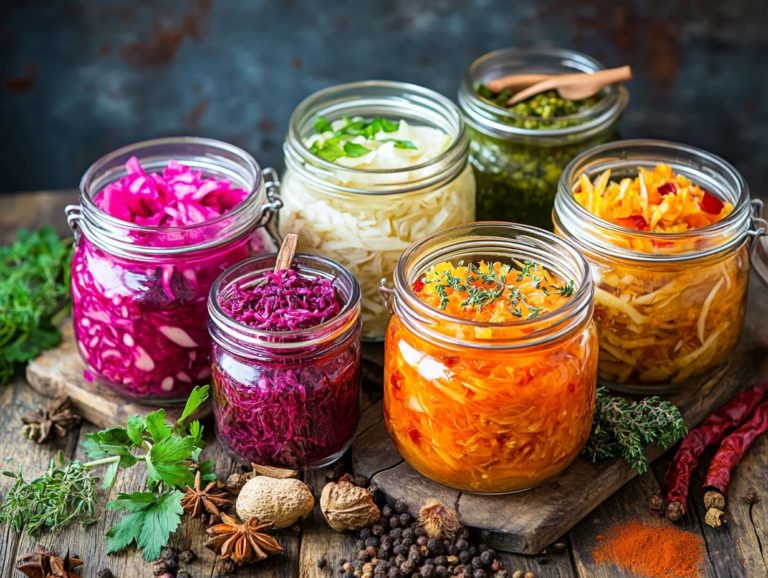The Importance of Fermentation in Beer Quality
Fermentation is a fascinating process that takes simple ingredients and transforms them into the rich flavors and enticing aromas of beer. Get ready to explore the essence of fermentation and how it operates, shining a spotlight on the vital role of yeast and the diverse varieties employed in brewing.
You ll discover how temperature control profoundly influences fermentation and why it s crucial for the quality of your beer, impacting everything from flavor and alcohol content to clarity. The article will also tackle common fermentation challenges and offer tips on how to sidestep them.
Embark on this brewing journey that unveils the secrets behind your favorite brew!
Contents
- Key Takeaways:
- What is Fermentation?
- What Happens During Fermentation?
- Types of Fermentation in Beer
- The Role of Yeast in Beer Fermentation
- The Importance of Temperature Control in Beer Fermentation
- Methods of Temperature Control in Fermentation
- The Influence of Fermentation on Beer Quality
- Common Issues in Beer Fermentation and How to Avoid Them
- Frequently Asked Questions
- What is fermentation and why is it important for beer quality?
- How does fermentation affect the flavor of beer?
- Why is temperature control important during fermentation?
- Can different yeast strains be used for fermentation and how do they impact beer quality?
- What role do sugars and malt play in fermentation and beer quality?
- How Does Fermentation Enhance Beer Quality and Stability?
Key Takeaways:
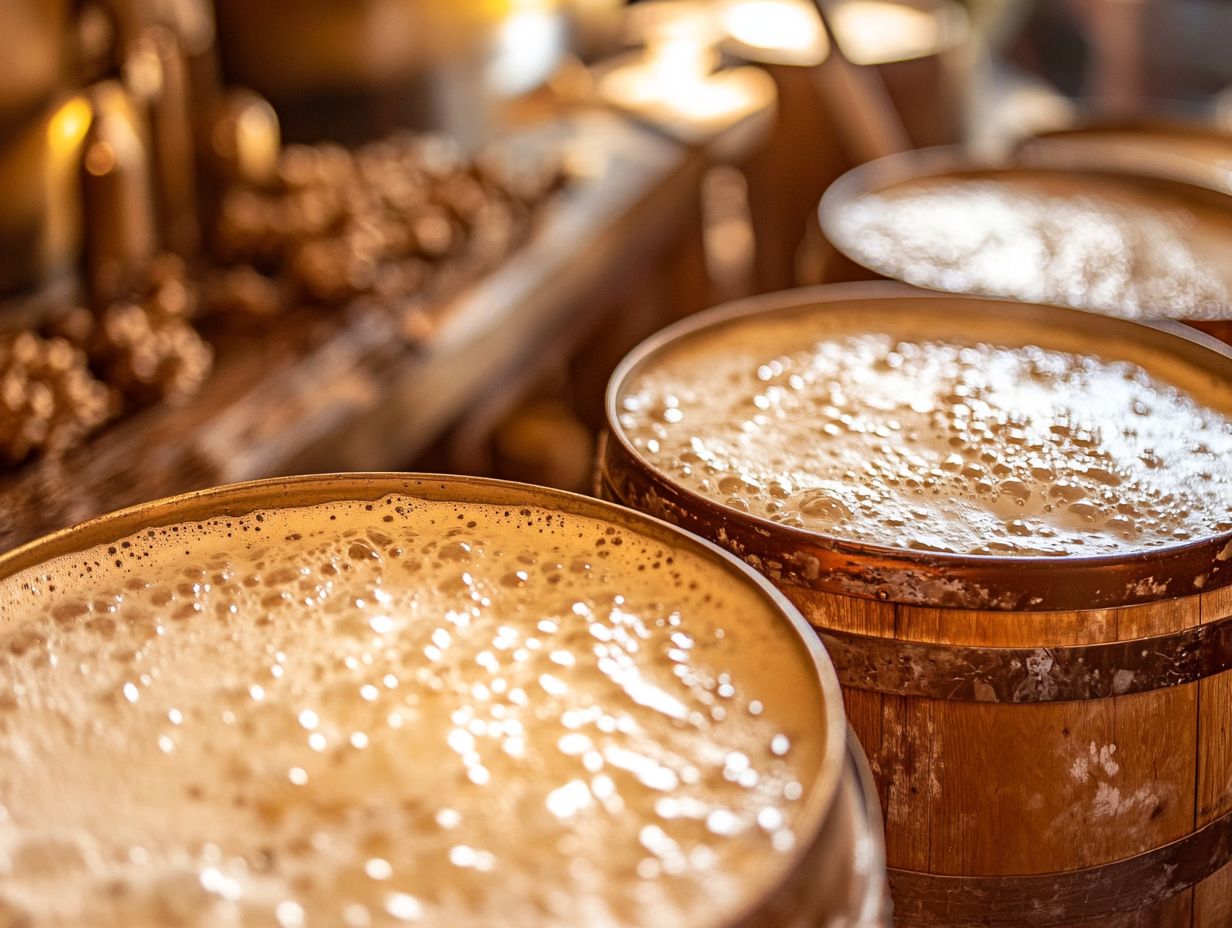
- Fermentation is a crucial step in the brewing process that converts sugars into alcohol and carbon dioxide, creating the unique flavors and aromas of beer.
- The type of yeast used and proper temperature control are essential factors in ensuring a successful fermentation process and high-quality beer.
- Fermentation greatly impacts the overall quality of beer, including its flavor, alcohol content, carbonation, and appearance.
What is Fermentation?
Fermentation is a complex process that transforms sugars into alcohol and carbon dioxide , driven by the activity of yeast tiny organisms that help in fermentation and other microorganisms. This process is essential in brewing, where particular strains of yeast, such as Saccharomyces cerevisiae, are instrumental in converting malted grains into a diverse array of flavorful beers, each boasting its unique profile of flavors and aromas.
The outcomes of fermentation can vary significantly based on the conditions in which it occurs and the types of sugars involved. This underscores its importance in both culinary and biomedical domains.
What Happens During Fermentation?
During fermentation, you ll witness yeast and other microorganisms working their magic on the sugars present in the wort. They metabolize these sugars, producing alcohol and carbon dioxide as byproducts, while simultaneously generating a diverse range of flavor compounds that contribute to the unique profiles of different beers.
This fascinating process unfolds in two main stages: primary fermentation and secondary fermentation. In the primary phase, yeast cells spring into action, eagerly consuming the simple sugars and converting them into ethanol and CO2. This is what gives your beverage those delightful bubbles. As fermentation progresses, various flavor compounds like esters, phenols, and higher alcohols emerge, each bringing their own distinct notes, ranging from fruity to spicy.
The secondary fermentation stage refines these flavors and allows the beer to mature and develop complexity. By grasping the nuances of these stages and their influence on taste, you can elevate your brewing experience, ultimately leading to the creation of truly remarkable craft beers.
Types of Fermentation in Beer
In the brewing industry, you ll encounter various fermentation processes that set the stage for the unique flavors of your favorite beers. You primarily distinguish between primary fermentation, secondary fermentation, and specific methods that employ particular yeast strains like Saccharomyces pastorianus for lagers and Lactobacillus for sour beers.
During primary fermentation, the magic begins as yeast kicks into gear, converting sugars into alcohol and carbon dioxide. This initial phase typically lasts from one to two weeks and is crucial for establishing the core of your brew. Once that s complete, secondary fermentation steps in, allowing for further flavor development and clarification. Here, brewers might introduce different yeast strains or bacteria to add those delightful, unique characteristics.
If you re aiming for a funky, complex flavor profile in a farmhouse ale, you might opt for Brettanomyces. Wild yeasts can yield distinct and intriguing sour profiles. Selecting the right yeast is essential, as each strain brings its own personality, contributing to the vast array of beer styles from crisp lagers to rich stouts and tangy sours.
Dive into the brewing process today and start crafting your masterpiece!
The Role of Yeast in Beer Fermentation
Yeast holds an essential place in the beer fermentation process. It serves as the key microorganism that transforms sugars into alcohol. Beyond this fundamental role, yeast also generates crucial flavor profiles that elevate the entire drinking experience.
The most prevalent yeast species, *Saccharomyces cerevisiae*, is critical for ales. In contrast, other strains, such as *Saccharomyces pastorianus*, are preferred for lagers. Each of these strains imparts unique characteristics to the final product, ensuring every sip is a remarkable exploration of taste.
Different Types of Yeast Used in Beer Fermentation
In the realm of beer fermentation, you ll find an array of yeast strains that are used. Saccharomyces cerevisiae takes the lead for ales, while Saccharomyces pastorianus holds court for lagers. Each strain contributes unique fermentation characteristics that shape the beer’s aroma, flavor, and overall quality.
But don’t stop there beyond these popular options, countless other yeast varieties await your discovery to elevate the complexity of your brews. Take Brettanomyces, for example; it’s often your go-to for sour and wild ales, adding funky, earthy notes and intricate layers of flavor through extended fermentation.
Then there are those delightful Belgian yeast strains like Saccharomyces pastorianus, which can unveil fruity and spicy flavors, making them perfect for crafting authentic Belgian-style ales.
As you dive into your exciting brewing adventure, keep in mind that the fermentation process is influenced by a variety of factors such as temperature, pitching rates (the amount of yeast added at the start of fermentation), and oxygen levels. These elements allow you to tailor your beer s profile, significantly impacting the final product.
With an abundance of options at your fingertips, each yeast strain presents a unique opportunity. Explore a spectrum of flavor possibilities and ultimately create distinctive, memorable brews!
Factors Affecting Yeast Activity in Fermentation
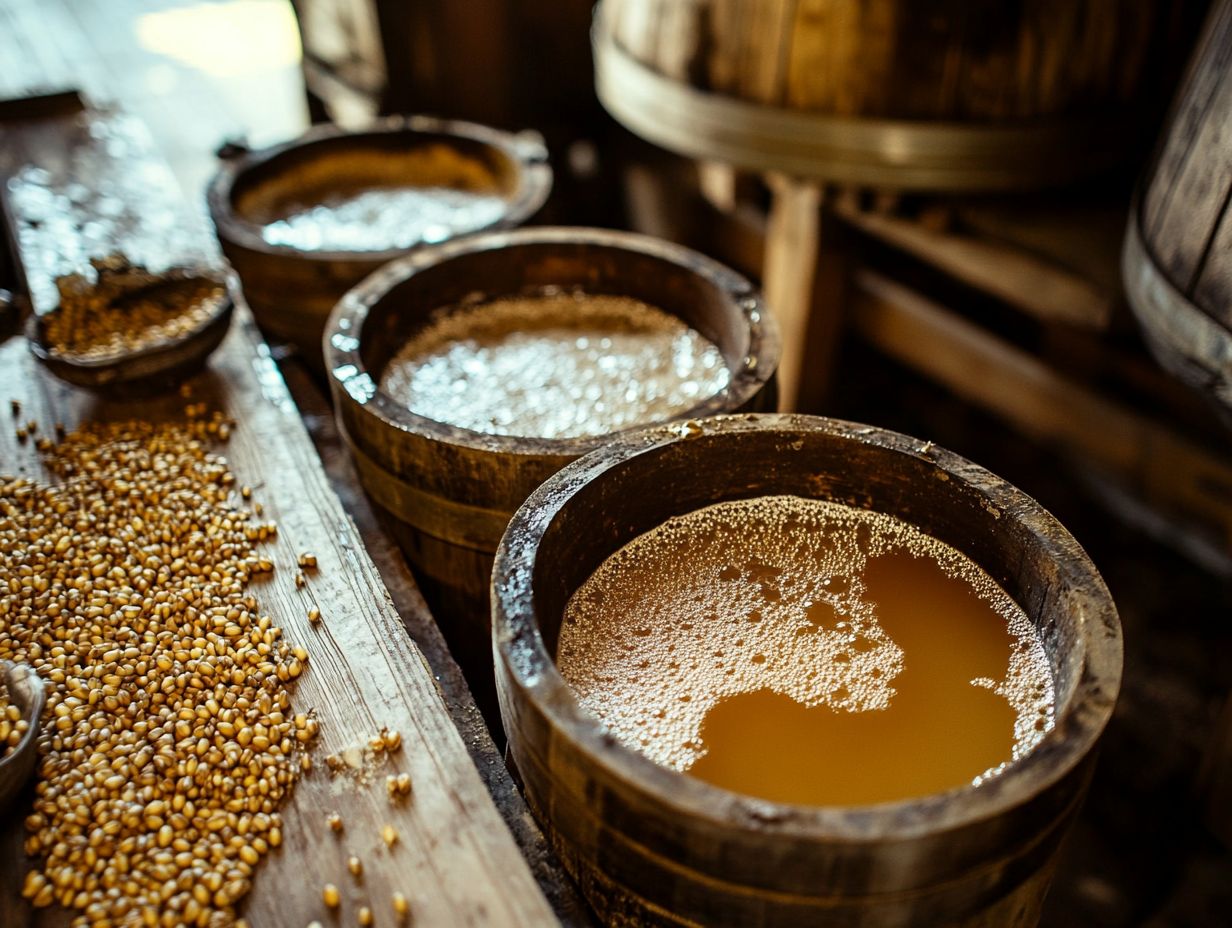
Your yeast activity during fermentation hinges on several factors, including fermentation temperature, the availability of essential nutrients like nitrogen, and sound yeast management practices. Each of these elements is crucial for ensuring optimal yeast vitality and achieving desirable fermentation results.
When these factors align, they create an ideal environment for yeast to flourish. This leads to more efficient fermentation processes. For example, maintaining the perfect temperature range encourages faster yeast growth and significantly reduces the risk of generating unwanted byproducts that could compromise your flavor profiles.
Equally important is ensuring an adequate nutrient supply; without sufficient nitrogen and other critical compounds, your yeast may struggle, resulting in sluggish fermentation or incomplete sugar conversion. By implementing effective yeast management techniques such as closely monitoring fermentation conditions and adjusting parameters as needed you can enhance both the quality and speed of your fermentation. This underscores the importance of paying meticulous attention to every detail in your brewing or winemaking process.
So go ahead start experimenting with different strains today and unlock a world of flavors in your brews!
The Importance of Temperature Control in Beer Fermentation
Temperature control plays a vital role in beer fermentation, as it profoundly impacts yeast activity, fermentation speed, and the overall quality of the final product.
By carefully regulating fermentation temperatures within your brewing systems, you can ensure that the yeast operates at its best. This attention to detail results in consistent flavor profiles and minimizes the risk of off-flavors, allowing you to craft a superior brew every time.
Effects of Temperature on Yeast Activity
Temperature directly influences yeast activity during fermentation. Even minor variations can lead to significant changes in fermentation speed, yeast growth, and the beer’s flavor and aroma profiles.
When the fermentation temperature dips too low, the yeast may become sluggish, causing fermentation to stall and resulting in off-flavors. Conversely, if the temperature climbs too high, it can stress the yeast and produce undesirable compounds, such as fusel alcohols, which are harmful byproducts of fermentation.
Different strains of yeast respond uniquely within specific temperature ranges: lager yeast typically flourishes at cooler temperatures around 45-55 F, facilitating a clean fermentation. In contrast, ale yeast performs best between 60-75 F, generating delightful fruity esters.
Striking a precise balance in temperature is essential. It not only affects the fermentation rate but also profoundly impacts the overall quality, mouthfeel, and complexity of the final beer, which is why understanding fermentation is key to craft beer success.
Methods of Temperature Control in Fermentation
Brewers utilize a variety of sophisticated methods for temperature control during fermentation. They employ systems equipped with cooling jackets, temperature sensors, and insulation to create the optimal environment for yeast activity. This ensures the success of the fermentation process.
Managing fermentation vessels and controlling oxygen content during fermentation are also critical. By skillfully managing fermentation temperatures, brewers keep yeast within its ideal range. This is a crucial factor in developing rich flavors, and understanding the role of fermentation in beer preservation helps prevent any undesirable off-flavors.
This includes controlling both primary fermentation and secondary fermentation stages. Active cooling systems, often powered by glycol chillers, offer precise temperature adjustments throughout the fermentation process, ensuring that every degree is accounted for.
Thermal insulation plays an equally important role by minimizing temperature fluctuations, thus protecting the integrity of the brew. This step is crucial for achieving a perfect brew where consistent conditions are key.
These techniques not only elevate the quality of the beer but also enhance yeast management and yeast nutrients. This leads to a consistent and high-quality final product that exceeds consumer expectations.
The Influence of Fermentation on Beer Quality
Fermentation plays a crucial role in determining the quality of the beer you enjoy. This process influences the alcohol content and carbonation levels, while also shaping the complex flavor profiles and aromas that define various beer styles.
Understanding this connection enhances your appreciation of the craft and the artistry behind each brew. The influence of fermentation temperature, brewing yeast, and malt is fundamental to this process.
Impact on Flavor and Aroma
The fermentation process is at the heart of developing the rich flavor profiles and enticing aromas of beers. As yeast metabolizes sugars, it produces a variety of compounds, including alcohol and carbon dioxide, that significantly enhance the sensory experience of the final product.
Consider the different fermentation characteristics temperature, yeast strain, and duration as they are crucial in shaping the complexity and uniqueness of each beer. For instance, fermenting at higher temperatures allows yeast to produce esters and phenols that create those delightful fruity and spicy notes often found in Belgian ales. This highlights the intricate dance of flavors that unfolds throughout the fermentation phase.
On the flip side, lagers, which prefer cooler fermentation temperatures, cultivate a cleaner profile featuring subtle malt sweetness and a crisp finish, allowing the hop bitterness to take center stage.
The yeast strain you choose further influences the flavor complexity and the overall fermentation outcome. Opting for a strain like American Ale yeast can amplify zesty citrus hop characteristics, while a German wheat yeast may introduce delightful banana and clove undertones. Each brew becomes a unique experience.
Effects on Alcohol Content and Carbonation
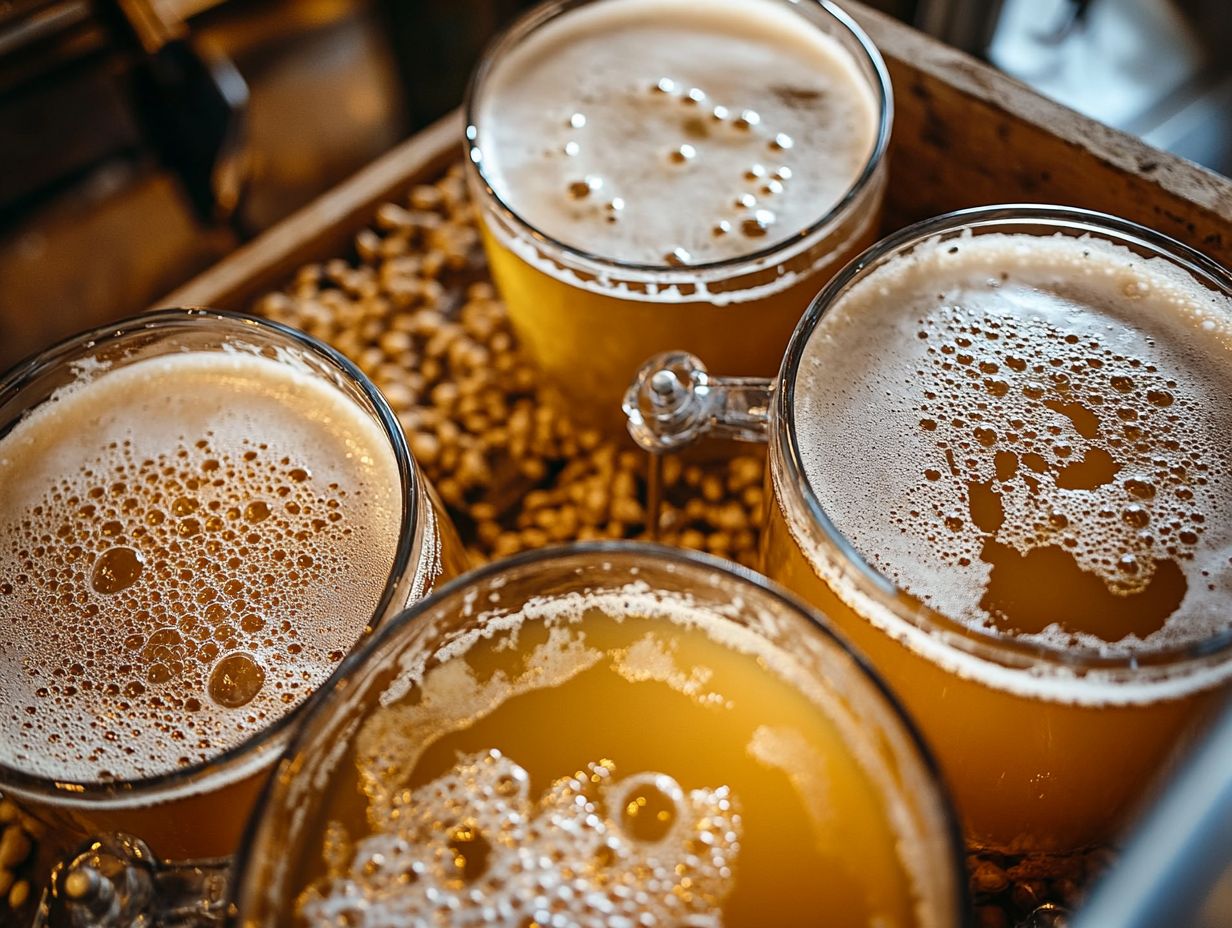
The fermentation process plays a crucial role in determining the alcohol content and carbonation levels in beer. Variations in yeast activity and fermentation conditions can lead to remarkable differences in the final product’s characteristics.
As you navigate through fermentation, the type of yeast you choose, along with critical factors like temperature, pressure, and sugar content of the wort, can significantly affect both the alcohol yield and the carbon dioxide produced. For example, ale yeast typically thrives at warmer temperatures, resulting in higher alcohol and carbonation levels compared to lager yeast, which prefers cooler environments.
You can refine your brewing craft by employing techniques such as controlling fermentation temperatures and adjusting the fermentation duration. This development impacts specific beer styles. The balance you achieve during this process influences not only the flavor profile and flavors, but also the mouthfeel, creating the crispness typically found in a lager versus the rich, robust character of an imperial stout. For a deeper understanding, consider exploring fermentation and beer quality, as lager yeast, such as Saccharomyces pastorianus, plays a crucial role in this process.
Influence on Color and Clarity
Both the color and clarity of your beer are shaped by the fermentation process. Your specific brewing techniques, ingredient choices, and understanding of the chemistry of living organisms are crucial in attaining the visual attributes that define your final product.
As fermentation unfolds, various factors, including the type of malt you select, can dramatically influence not just the hue but also the transparency of your brew. For instance, darker malts can lend rich colors, ranging from deep amber to pitch black, depending on how roasted they are. Understanding these aspects of brewing history is essential for any passionate brewer!
The clarity of your beer can also be impacted by the fermentation method you use. Techniques like cold crashing can effectively settle particulates, resulting in a polished appearance.
The yeast strains you choose also significantly impact the beer’s clarity, affecting how light interacts with the liquid and enhancing the overall aesthetic of your finished creation.
Common Issues in Beer Fermentation and How to Avoid Them
Common issues in beer fermentation, such as microbial contamination, stuck fermentation, and off-flavors, can profoundly affect the quality and safety of your brew. Effective yeast management and stringent sanitation practices are essential for any brewer aiming to create exceptional beer.
Contamination
Microbial contamination during fermentation can result in undesirable off-flavors and spoilage. This is driven by unwanted microorganisms that outcompete your yeast for essential nutrients and disrupt the fermentation environment.
You may encounter various types of microbes, including wild yeasts, bacteria, and molds. Each can introduce distinct flavors and aromas that detract from the intended profile of your beer. For instance, Brettanomyces can lend funky, sour notes, while lactic acid bacteria can produce an excess of acidity.
Contamination often stems from inadequate sanitation practices, exposure to wild yeast in your brewing environment, or the use of contaminated equipment. Act quickly! Implement strict cleaning routines with appropriate sanitizers to safeguard your brew from contamination. Regularly inspect and maintain all your equipment, and consider adopting closed fermentation systems to limit exposure to unwanted microorganisms.
By employing effective fermentation management techniques, you can significantly elevate the quality and consistency of your final product.
Stuck Fermentation
Stuck fermentation can be quite a headache! It occurs when yeast activity comes to a premature halt, preventing the complete conversion of sugars and jeopardizing the beer’s quality and desired characteristics.
This issue can arise from various factors, including improper fermentation conditions like temperature fluctuations and inadequate oxygen levels. Poor yeast management, such as using too few viable yeast cells or neglecting to maintain optimal pH levels, can worsen the problem.
To address stuck fermentations, you can employ several effective strategies:
- Gently stir the fermenting beer to reignite yeast activity.
- Pitch fresh yeast to reinitiate the fermentation process.
By closely monitoring and adjusting temperature and nutrient levels, you can restore yeast health, ultimately leading to a successful fermentation outcome. Proper management of yeast vitality and fermentation adaptation are also key strategies.
Off-flavors
Off-flavors in beer can arise from a variety of fermentation issues, often rooted in poor yeast practices, inadequate sanitation, or extreme fermentation conditions that stress the yeast.
These unwanted tastes can manifest as sourness, skunky notes, or off-aromas that might remind you of sweat or vinegar. For instance, diacetyl, that unmistakable buttery flavor, typically results when the yeast fails to reabsorb this compound during fermentation. Certain yeast strains may produce elevated levels of phenolic compounds compounds that can impact flavor leading to clove or medicinal flavors when under stress.
To avoid these troublesome off-flavors, it’s essential to implement effective yeast management methods. This includes pitching the right quantities of yeast and maintaining optimal temperature ranges throughout the brewing process. Additionally, ensuring proper sanitation will help eliminate unwanted microorganisms that could exacerbate fermentation problems, which can also affect the color of your beer.
Frequently Asked Questions
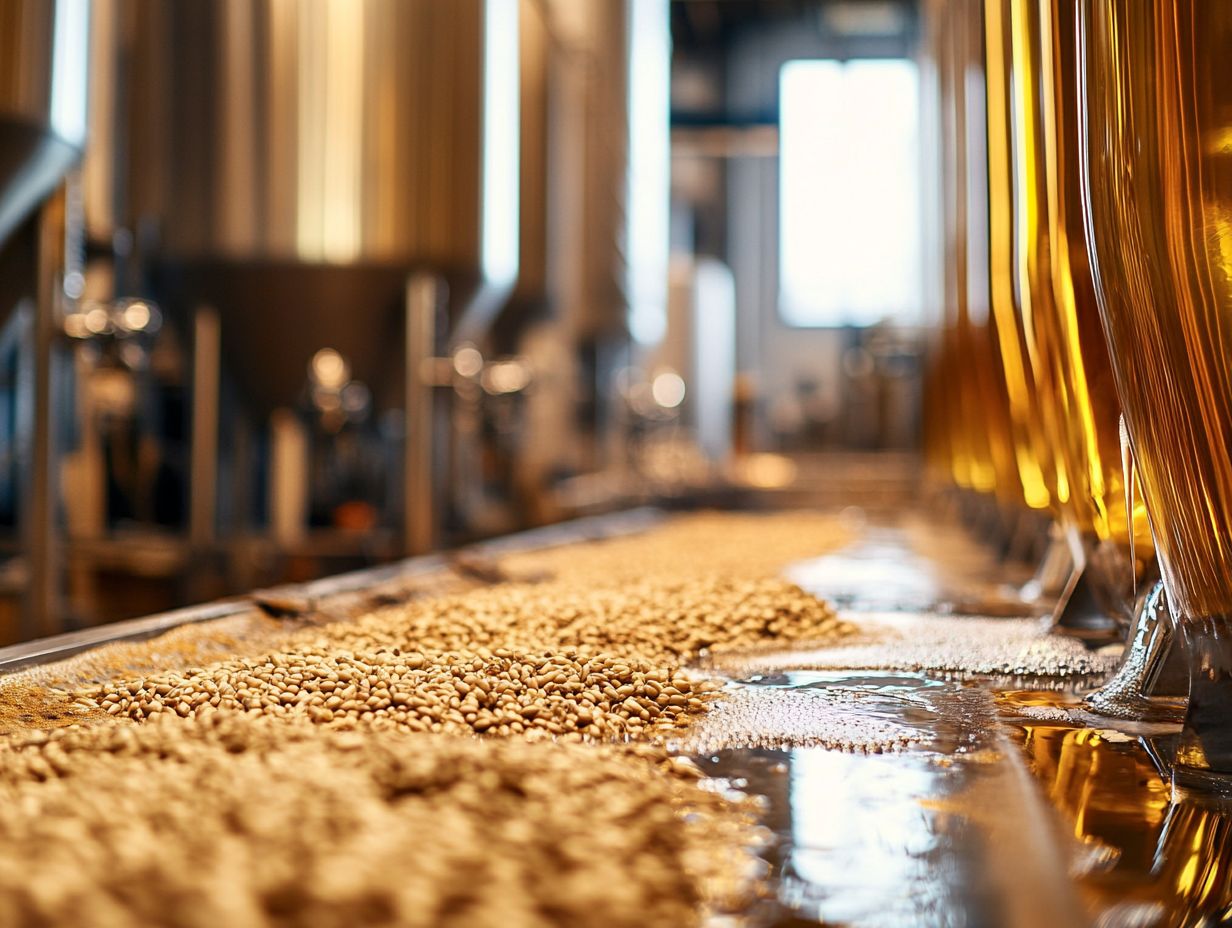
What is fermentation and why is it important for beer quality?
Fermentation is the process by which yeast converts sugars into alcohol and carbon dioxide, resulting in the production of beer. This process is crucial for beer quality as it not only creates alcohol content but also adds unique flavors and aromas to the beer.
How does fermentation affect the flavor of beer?
Fermentation plays a significant role in the development of flavors in beer. Yeast produces different flavor compounds during fermentation, such as esters, phenols, and alcohols, which contribute to the taste and aroma of the beer. The type of yeast strain and fermentation temperature also influence the flavor profile.
Why is temperature control important during fermentation?
Maintaining a consistent fermentation temperature during primary fermentation is crucial for producing high-quality beer. If the temperature is too high, the yeast may produce off-flavors, while a low temperature can slow down or even halt fermentation, resulting in a flat or unfinished beer. Proper yeast management and control of fermentation conditions are essential for successful brewing.
Can different yeast strains be used for fermentation and how do they impact beer quality?
Yes, there are many different strains of yeast that can be used for fermentation, each with its unique characteristics. Different yeast strains, including Saccharomyces cerevisiae and Saccharomyces pastorianus, can produce varying levels of alcohol, carbonation, and flavors. These variations can significantly impact the quality, flavor profiles, and aromas of the beer. The choice of yeast is a crucial aspect of brewing techniques and overall beer quality.
What role do sugars and malt play in fermentation and beer quality?
Sugars are essential for fermentation as they provide food for the yeast. The type and amount of sugar, as well as the malt used in the brewing process, can affect the final alcohol content, residual sweetness, and flavor of the beer. Additionally, yeast nutrients and the oxygen content in the wort are important for yeast growth and fermentation outcomes.
How Does Fermentation Enhance Beer Quality and Stability?
Fermentation creates alcohol and flavor compounds in beer. It also extends shelf life by acting as a natural preservative.
This process helps clarify the beer by settling out unwanted particles. The result is a smoother, more consistent taste.
Managing fermentation stages carefully is crucial. It prevents bacteria and other unwanted organisms, ensuring the best fermentation results.

